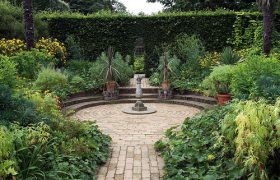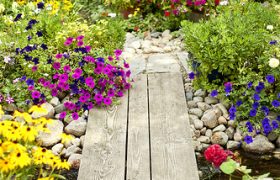Protect your deciduous shrubs which are tender. Shrubs in pots especially need special care in the colder weather. You want to then tie the tops of the canes together, and cover them with a sheet or blanket. This will work better than wrapping your plant with plastic, because air can still circulate, which will help to prevent rotting.
Plant for fall color. A lot of gardeners see fall as the time to wind things down in the garden, but with some plants the opposite is true. Certain trees and shrubs really ‘come alive’ in the fall, offering vivid displays of color through their foliage. Trees and shrubs for fall color include maple, cornus, gingko, dogwood, sumac and viburnum.
Plant a variety of annuals, biennials and perennials to keep your flower beds bright. These usually grow quickly, and provide an easy-to-change solution to making your flower beds bright and beautiful. They allow you to select different flowers from one year or season to the next. Sunny areas in the middle of shrubs and perennials can be filled in nicely with these plants. Attention-getting options exist such as sunflowers and petunias.
Most people design their gardens with plants in their hands and a shovel. However, the best idea is to wait to choose your plants after you have decided upon a layout or landscaping design. Once you have completed the landscaping, move on to the last step to your garden; planting your favorite flowers, shrubs and trees.
Clean up your garden at the end of the growing season. If you clean up your garden when the growing season is over, it will improve the appearance and make less work for you the following year. Remove dead or damaged branches on trees and shrubs, get rid of weeds before they go to seed, and rake any leaves from the lawn. Remove old annual plants and cut perennials to the ground if they normally die back in the winter. Any plant material that isn’t diseased can be put in the compost pile.
Remember to mulch before the first freeze. Spread compost or shredded leaves around the garden, mulching under shrubs, hedges, roses, and on top of the crown of any tender perennials. A layer of compost spread on bare ground will help to protect any bulbs, corms or plant roots. By springtime, this compost will have been taken into the ground by worms, and your soil will be full of nutrition, ready for new planting.
Create living walls in your garden. A living wall can take many forms: it can be as tall or low as you want, informal or formal, a single plant or created out of multiple plants. A wall of forsythia, lilac or roses offers eye-level blossoms and fragrance. Some people like the look of a formal, clipped hedge of privet or boxwood. Many flowering shrubs can be adapted to form a hedge, such as hebe, abelia or diosma. For existing structures, such as a fence or trellis, a vine such as clematis or morning glory can cover it in a season, offering a vivid display of vertical color.





